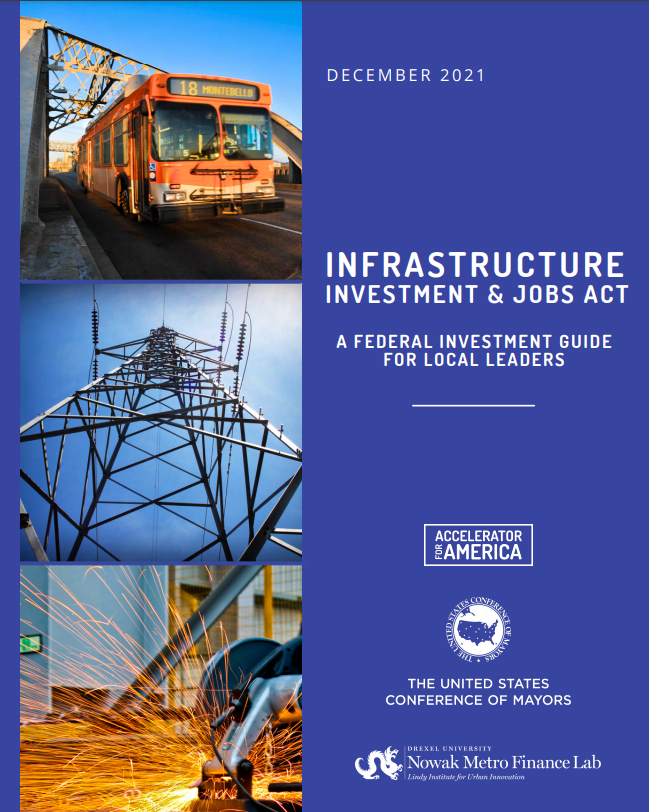
Share On Social!
In November 2021, Congress passed the $1.2 trillion bipartisan Infrastructure Investment and Jobs Act to rebuild roads, expand access to clean drinking water and high-speed internet, and tackle climate change — with priority investments in Latino and other often left-behind communities.
Although this bill adds new money to fix some transportation problems, it pours hundreds of billions into the same old highway programs that perpetuate those problems, like auto-dependence and dangerous roads.
“Today’s transportation system works extraordinarily well for its original intended purpose, to build a national highway system, but fails to meet the climate, economic recovery, equity, and safety challenges of the present day,” according to the National Association of City Transportation Officials (NACTO).
That is why it falls to state and local governments to capitalize on federal infrastructure funds to try to meet climate, economic recovery, equity, and safety challenges in transportation.
Drexel University even created an investment guide to support local leaders in using the infrastructure funds for transformational action to advance economic competitiveness, sustainability, and improve equity. They recommend building on the partnerships that were created to organize and prepare for federal recovery dollars through the American Rescue Plan Act, which also seeks to address equity and infrastructure.
But the guide doesn’t explain how to build on partnerships.
Our team at Salud America! believes future partnerships would benefit from an understanding “expenditure category” linkages between the American Rescue Plan Act and grant programs within the Infrastructure Investment and Jobs Act.
American Rescue Plan Expenditure Categories and Performance Indicators
The $1.9 trillion American Rescue Plan Act was passed in March 2021 to aid public health and economic recovery from the COVID-19 pandemic.
The Rescue Plan required all states and territories and metropolitan cities and counties with a population over 250,000 residents to produce a Recovery Plan Performance Report if receiving State and Local Fiscal Recovery Funds awards.
“The Recovery Plan Performance Report will provide the public and [Department of the Treasury] information on the projects that recipients are undertaking with program funding and how they are planning to ensure project outcomes are achieved in an effective, efficient, and equitable manner,” according to the interim final rule.
Recovery plan reports must include: an explanation of efforts to achieve or promote equitable outcomes; an explanation of evidence-based and evaluation efforts; a table of project expenses by expenditure category; and key performance indicators, some of which can be determined by the jurisdiction and some of which are required by the Treasury, according the performance report template.
Regarding equity, jurisdictions must describe the following in their recovery plans:
- Efforts to promote equitable outcomes, including how programs were designed with equity in mind.
- How the overall equity strategy translates into services to disproportionately impacted communities, such as services to address health disparities and the social determinants of health, build stronger neighborhoods and communities, address educational disparities, and promote healthy childhood environments
- The geographic and demographic distribution of funding, including whether it is targeted toward traditionally marginalized communities.
- How your jurisdiction’s planned or current use of funds incorporates written, oral, and other forms of input that capture diverse feedback from constituents, community-based organizations, and the communities themselves.
Regarding evaluation efforts, jurisdictions must explain the goals of the project, the evidence base for the interventions, and/or if projects are being evaluated through rigorous program evaluations that are designed to build evidence.
Regarding expenditure categories, jurisdictions can spend on public health, negative economic impacts, services to disproportionately impacted communities, and infrastructure, which include the following sub-categories:
- public health services
- food programs
- rent/mortgage/utility aid
- job training assistance
- affordable housing
- social determinants of health
- lead remediation
- combined sewer overflow
- drinking water
- broadband projects
Regarding mandatory performance indicators, indicators include number of affordable housing units preserved or developed, number of workers completing sectoral job training programs, and number of people participating in summer youth employment programs.
With all these elements, how can jurisdictions truly achieve equity?

The assumption of the American Rescue Plan is that cross-sector partnerships are necessary to achieve equitable outcomes across various expenditure categories.
However, there is inconsistent evidence of partnerships in the initial county recovery plans, which were due August 31, 2021.
You can access county recovery plans through the National Association of Counties and state recovery plans through the National Association of State Budget Officers. City recovery plans are available in a separate search.
Ideally, the partnerships developed when creating the recovery plans could provide a guide for addressing equity issues and similar challenges when implementing the Infrastructure Investment and Jobs Act.
But first, it may help to have a better understanding of expenditure category linkages between the American Rescue Act recovery plans and grant programs in the Infrastructure Investment and Jobs Act.
Connecting Expenditure Categories Between the American Rescue Act and the Infrastructure Investment and Jobs Act
The following expenditure categories are from the Recovery Plan guidance with each including the relevant Infrastructure Investment and Jobs Act grant programs—formula and competitive—as well as page numbers from the Infrastructure Investment and Jobs Act investment guide from Drexel.
Public Health:
- Other Public Health Services (Enhanced Mobility for Seniors and Individuals with Disabilities Program (p. 32))
Negative Economic Impacts:
- Household Assistance: Internet Access Programs (Digital Equity Act, p. 23)
- Job Training Assistance (Digital Equity Act, p. 23; Energy Efficiency and Conservation Block Grant Program, p. 32)
- Aid to Nonprofit Organizations (Digital Equity Act, p. 23; Enhanced Mobility for Seniors and Individuals with Disabilities Program, p. 32)
- Aid to Other Impacted Industries (Low or No Emission Vehicle Program, p. 14; State of Good Repair Formula Grants, p. 17)
- Aid to Other Impacted Industries (Broadband Equity, Access, and Deployment Program (p. 22))
 Services to Disproportionately Impacted Communities:
Services to Disproportionately Impacted Communities:
- Education Assistance: Other (Healthy School Bus Program, p. 22)
- Healthy Childhood Environments: Other (Healthy School Bus Program, p. 22; Reconnecting Communities Initiative, p. 25; Safe Streets and Roads for All Grant Program, p. 26; Transportation Alternatives Program Set Aside, p. 28; Active Transportation Infrastructure Investment Program, p. 32; Healthy Streets Program, p. 33)
- Social Determinants of Health: Other (Building Resilient Infrastructure and Communities (BRIC) Program, p. 12; Rebuilding American Infrastructure With Sustainability and Equity Grant Program, p. 15; Congestion Mitigation and Air Quality Improvement Program, p. 16; State of Good Repair Formula Grants, p. 17; Congestion Relief Program, p. 23; Promoting Resilient Operations for Transformative, Efficient, and Cost-Saving Transportation Grant Program, p. 25; Reconnecting Communities Initiative, p. 25; Strengthening Mobility & Revolutionizing Technology Grants, p. 27; Transportation Alternatives Program Set Aside, p. 28; Active Transportation Infrastructure Investment Program, p. 32; Healthy Streets Program, p. 33)
- Social Determinants of Health: Lead Remediation (Clean Water and Drinking Water State Revolving Funds, p. 13; Lead Service Line Replacement, p. 15; Hazardous Substance Superfund Remediation, p. 19)
- Social Determinants of Health: Community Violence Interventions (Safe Streets and Roads for All Grant Program, p. 26; Strengthening Mobility & Revolutionizing Technology Grants, p. 27; Healthy Streets Program, p. 33)
Infrastructure:
- Combined Sewer Overflows (Sewer Overflow and Stormwater Reuse Municipal Grants, p. 32)
- Other Sewer Infrastructure (Sewer Overflow and Stormwater Reuse Municipal Grants, p. 32)
- Stormwater (Surface Transportation Block Grant Program, p. 17; Army Corps Construction Projects, Operations, Maintenance, and Coastal Emergency Management, p. 18; Sewer Overflow and Stormwater Reuse Municipal Grants, p. 32)
- Energy Conservation (Congestion Mitigation and Air Quality Improvement Program, p. 16; Congestion Relief Program, p. 23; Transmission Facilitation Program Revolving Loan Fund, p. 27; Transportation Alternatives Program Set Aside, p. 28; Energy Efficiency and Conservation Block Grant Program, p. 32)
- Drinking Water: Treatment (Clean Water and Drinking Water State Revolving Funds, p. 13); Transmission and Distribution (Clean Water and Drinking Water State Revolving Funds, p. 13, Water Infrastructure Financing and Innovation Act, p. 31); Lead Remediation (Clean Water and Drinking Water State Revolving Funds, p. 13; Lead Service Line Replacement, p. 15; Hazardous Substance Superfund Remediation, p. 19)
- Broadband “Last Mile” Projects (Broadband Equity, Access, and Deployment Program, p. 22; Digital Equity Act, p. 23)
- Broadband Other Projects (Broadband Equity, Access, and Deployment Program, p. 22; Digital Equity Act, p. 23)
“[Infrastructure Investment and Jobs Act] funds will be most transformative when used as a supplement to strategic local and regional projects that advance economic competitiveness, sustainability, and improve equity; they will fall short of their potential when treated as many individual pots of money to be separately competed over and managed in silos,” according the investment guide by Drexel.
However, transportation is largely missing from recovery plan expenditure categories and performance indicators.
Need to Strengthen the Transportation Connection
Inadequate transportation can negatively impact social, economic, and health outcomes.
Yet none of the recovery plan expenditure categories or mandatory performance indicators of the Infrastructure Investment and Jobs Act include transportation-specific categories or indicators.
Thus, state and local leaders will likely need to put additional effort into explaining the evidence base for transportation interventions to reduce negative economic impacts and provide services to disproportionately impacted communities.
Similarly, state and local leaders will need to put additional effort into developing transportation-related performance indicators.
For example, it is well documented that transportation is the second-largest household expense and that many American households are burdened by transportation costs, which means they spend more than 15% of their annual income on transportation.
Here are a handful of counties where households are burdened by spending more than 22% of their income on transportation, according to the Center for Neighborhood Technology’s Housing + Transportation Index:
- Bexar County, Texas (60.7% Latino). 75% of households spend more than 22% of their income on transportation.
- Broward County, Florida (31.1% Latino). 83% of households spend more than 22% of their income on transportation
- Clark County, Nevada (31.6% Latino). 78% of households spend more than 22% of their income on transportation
- Durham County, North Carolina (13.7% Latino). 47% of households spend more than 22% of their income transportation
- Kane County, Illinois (32.4% Latino). 67% of households spend more than 22% of their income on transportation
- Pinal County, Arizona (30.7% Latino). 72% of households spend more than 26% of their income on transportation.
Transportation-cost burdened households are disadvantaged households.
That is why it is important to consider housing and transportation affordability or location affordability rather than merely housing affordability.
 Thus, to reduce negative economic impacts from COVID-19, jurisdictions should consider transportation assistance and other strategies that provide disadvantaged groups with access to education, jobs, and opportunity.
Thus, to reduce negative economic impacts from COVID-19, jurisdictions should consider transportation assistance and other strategies that provide disadvantaged groups with access to education, jobs, and opportunity.
Because housing is not affordable if the occupants are spending 22% of their income on transportation, state and local leaders should consider transportation affordability performance indicators to accompany the mandatory performance indicator of “number of affordable housing units preserved or developed.”
Similarly, because transportation is often a major barrier to jobs and job training, state and local leaders should consider transportation-related performance indicators to accompany the mandatory performance indicators of “number workers completing sectoral job training programs” and “people participating in summer youth employment programs.”
Consider exploring your local community need assessments to better understand how transportation barriers impact employment and self-sufficiency. Try this Google search, “[YOUR CITY/COUNTY] community action agency community needs assessment.”
Moreover, when it comes to safe and feasible transportation options to access to education, jobs, and opportunity, neighborhoods were not created equal.
Thus, beyond individual transportation assistance, it is important to consider transportation as a social determinant of health and improve transportation options in disproportionately impacted communities.
To advance economic competitiveness, sustainability, and improve equity, state and local leaders should work with partners to simultaneously advance American Rescue Act Recovery Plans and implement the Infrastructure Investment and Jobs Act.
How Can You Push for More Equitable Systems in Your Area?
Download the Salud America! Health Equity Report Card for your area!
The Report Card auto-generates Latino-focused and local data with interactive maps and comparative gauges, which can help you visualize and explore inequities in housing, transportation, poverty, health care, food, and education.
You will see how your county stacks up in these health equity issues — now including social vulnerability and COVID-19 — compared to your state and the nation.
Then you can share the Report Card with your local leaders to advocate for healthy change!
Get your Health Equity Report Card!
By The Numbers
27
percent
of Latinos rely on public transit (compared to 14% of whites).



